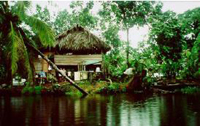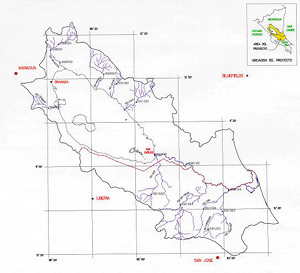- English
- Español
Integrated Water Resources Management
Past Projects
Publications
Formulation of Strategic Action Plan for the Integrated Management of Water Resources and the Sustainable Development of the San Juan River Basin and its Coastal Zone
Background
 The San Juan River Basin (SJRB) project covers some 38,500 km² in the basin itself, plus its associated coastal zone in the Caribbean Sea. Of the land area, 64% is in southern Nicaragua and 36% in northern Costa Rica. The planning area covers the subbasins of Lake Nicaragua and of the San Juan River, as well as four smaller, but nonetheless significant, subbasins with natural links to this system--the Indio and Maiz river basins in Nicaragua, and the Colorado and Tortuguero river basins in Costa Rica.
The San Juan River Basin (SJRB) project covers some 38,500 km² in the basin itself, plus its associated coastal zone in the Caribbean Sea. Of the land area, 64% is in southern Nicaragua and 36% in northern Costa Rica. The planning area covers the subbasins of Lake Nicaragua and of the San Juan River, as well as four smaller, but nonetheless significant, subbasins with natural links to this system--the Indio and Maiz river basins in Nicaragua, and the Colorado and Tortuguero river basins in Costa Rica.
The waters of the Lake Nicaragua-San Juan River watershed flow through at least
eight distinct terrestrial ecosystems: (i) dry tropical forest to the east,
north, and west of Lake Nicaragua; (ii) cloud forest in the high areas of the
Central Volcanic Cordillera of Costa Rica; (iii) moist tropical forest to the
south and southwest of Lake Nicaragua and the eastern foothills; (iv) very moist
tropical forest in the San Juan Valley and coastal plains; (v) gallery forest
along river banks; (vi) wetlands to the south of Lake Nicaragua and at the
confluences of the Colorado and Tortuguero rivers with the San Juan; (vii)
second-growth forest, meadows, and agricultural land in extensive areas of the
basin; and (viii) coastal forest and mangrove swamps on the Caribbean coast. The
Indio and Maiz river basins are mostly covered by moist to very moist tropical
forest.
Due to this range of ecosystems and associated habitats, the SJRB has a wealth
of biodiversity. Its location in the natural biological corridor running the
length of Central America has made it a meeting ground for species all the way
from the subarctic areas of North America to others from the subtropics of South
America. To a great extent, its natural history is unique. The low population
density in many parts of the SJRB has kept it relatively pristine, although
there is little information on the potential future impact of human migration
trends and the spread of agriculture in the basin.
Although not included in the project area, Lake Managua has been temporarily connected with the SJRB at times and thus will be taken into consideration during the formulation of the Strategic Action Plan (SAP) for the basin. For example, the torrential rainfall associated with Hurricane Mitch in October 1998 caused Lake Managua to overflow its banks, flooding the surrounding areas and sending water into Lake Nicaragua. To prevent such flooding in the future, the Nicaragua government now intends to regulate the waters of Lake Managua, which will make transfers to Lake Nicaragua more frequent. Various studies, in particular those undertaken by the Inter-American Development Bank (IDB) and the German Technical Cooperation Agency (GTZ), have shown that Lake Managua is extremely polluted. Thus Lake Nicaragua faces the threat of an influx of heavy metals, agrochemical waste associated with pesticides and fertilizers, and industrial and urban effluents, all of which would diminish the quality of its waters. With this in mind, the SJRB project will work in close coordination with initiatives or plans to regulate the level of Lake Managua. Close co-operation with the UNEP (United Nations Environment Program/GEF (Global Environment Facility) project "Reducing Pesticide Runoff to the Caribbean" executed by the office of the Regional Seas Programme for the Caribbean (CAR-RCU) is anticipated.
Challenges

Currently, both Nicaragua and Costa Rica lack adequate technical and
institutional capacity to collect comprehensive data on the SJRB and to
implement effective policies for watershed planning and integrated management
that are needed to protect and rehabilitate water resources and ecosystems.
Paucity of resources, poor transportation infrastructure, the lack of
recognition of women in Natural Resource Management, and weak local institutions
are common on both sides of the border. Given this situation, the governments of
Costa Rica and Nicaragua have proposed a joint approach to best manage this
complex hydrologic system, within the constraints imposed by demography and
geography.
Regional studies now being carried out by
the Central American Committee on Water Resources, with international
cooperation, lead to the conclusion that the fresh water in the San Juan Basin
is the only source capable of meeting the foreseeable development needs of the
semiarid Pacific slope of Central America, the region’s most populated area.
Thus, there is a likelihood that this system will come under increasing pressure
of human exploitation. In addition, because the SJRB is also a common westward
passageway for anticyclones from the Atlantic to the Pacific, the threat of
hurricanes and tropical storms, coupled with the threats posed by volcanic
activity and seismic pressures that already make this fresh water supply
especially vulnerable, further exacerbates the human pressures likely to be
experienced within this hydrologic system.
The GEF Operational Strategy lists four major areas of concern relating to
international waters: (i) degradation of the quality of water resources; (ii)
physical habitat degradation of coastal and near-shore marine areas, lakes, and
watercourses; (iii) the introduction of exotic species that disrupt aquatic and
land ecosystems and (iv) excessive and/or inappropriate exploitation of
resources due to inadequate management and control measures. All of these
problems were identified in the SJRB during the Transboundary Diagnostic
Analysis (TDA), which was carried out with PDF Block B funds. The analysis was
implemented with the active participation of key stakeholders, and based upon an
earlier study, carried out jointly by UNEP and the OAS, which pointed to a
number of current and emerging problems that threaten the sustainability of
development in the San Juan River Basin and ultimately the quality of life of
the people who live there. These transboundary environmental problems often have
common roots and manifest themselves both individually and collectively. They
are closely interrelated, but in the interest of seeking solutions they have
been broken down as follows:
- Accelerating degradation of transboundary ecosystems
- Overexploitation of valuable natural resources
- Soil degradation and increasing sedimentation
- Pollution of water bodies
- High vulnerability to natural hazards
- Root causes (Matrix)
Project Goals
The purpose of this request is to procure financing for the
formulation of a Strategic Action Program (SAP) for the integrated management of
water resources and the sustainable development of the San Juan River Basin and
its Coastal Zone. The ultimate objective of the SAP is to ensure the
availability of goods and services provided by water resources for conserving
natural ecosystems and social and economic development, in order to satisfy
present and future demands as agreed by all parties involved. In this way
conflicts related to the use of the goods and services generated by SJRB
ecosystems will be minimized through a coordinated program of action conducted
jointly by the two countries.
The major components of the SAP formulation include: (i) the
strengthening of a basin-wide information system that provides the mechanisms
for the gathering and dissemination of data adequate to the needs of
decision-making for the integrated management of the basin; (ii) the creation of
a well-coordinated bilateral planning process for the SJRB; (iii) the
implementation of a gender oriented public participation process; (iv) the
strengthening of public institutions and private organizations; and (v) the
formulation and implementation of environmental education activities.
Coordination between the two countries is an important
mechanism that can help to improve the quality of life of the inhabitants and
protect the ecosystem. This cooperation will support the coordination of
research and transboundary management. It will permit the interaction of
government institutions and NGOs, strengthening both and making possible a more
integrated – and thus more sustainable – development.
The SAP will firstly create a framework for future action and a timetable of
activities for the protection and use of the numerous goods and services offered
by the water resources and ecosystems of the SJRB. It will thus promote the
sustainable development of the region. Secondarily the SAP will lay out a series
of measures to reduce and/or eliminate current and emerging problems affecting
the conservation and development of the SJRB. It will enhance the transboundary
and global benefits obtained when development is both integrated and
participatory, and when environmental education, technology transfer, and
institutional strengthening are key elements of a program. Furthermore the SAP
will address priority transboundary needs and focus on long-term solutions to
the current and emerging problems facing the SJRB. Lastly it will propose a
series of projects based on experience gathered from demonstrations of new
technologies, taking into account their real costs and the capacity of the
institutions and organizations involved to execute them.
Location of the Project

Partners
- Funding source: Global Environment Facility - GEF
- GEF Implementing Agency: United Nations Environmental Programme (UNEP)
- Executing Agency: Organization of American States
- National Executing Agency: Ministry of the Environment, Energy and Telecommunications (Costa Rica) and Ministry of Environment and Natural Resources (Nicaragua)
Resources


